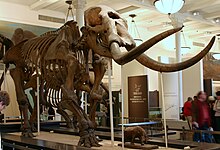
The research history of Mammut is extensive given its complicated taxonomic and non-taxonomic histories, with the earliest recorded fossil finds dating back to 1705 in Claverack, New York during the colonial era of what is now the United States of America. Initially thought to belong to biblical antediluvian giants, the fossils were later determined to belong to a proboscidean species as a result of more complete 18th century finds from the locality of Big Bone Lick in what is now Kentucky. The molars were studied by European and American naturalists, who were generally baffled on its lack of analogue to modern elephants, leading to varying hypothesis on the affinities of the teeth. More complete skeletons were found after the independence of the United States colonies from Great Britain within the early 19th century. American historians of the 21st century have made arguments that the early history of M. americanum finds and studies played major roles in shaping American nationalism on the basis of the large sizes and relative completeness of the fossils to disprove the negative theory of social degeneracy in North America.
Taxonomically, the mammutid was recognized as a distinct species by Robert Kerr in 1792 ("Elephas" americanus) and as the genus Mammut by Johann Friedrich Blumenbach in 1799. Mammut is one of the first fossil mammal genera to be erected with valid taxonomic authority. However, naturalists of the 19th century generally adopted the name Mastodon, which was established as an informal term in 1806 and as a genus in 1817 by the French naturalist Georges Cuvier. "Mastodon" for its taxonomic history served as a wastebasket taxon for any fossil proboscidean species whose dentitions appeared closer to Mammut americanum than to those of the Elephantidae or Deinotheriidae. The genus Mammut and its type species M. americanum have both accumulated plenty of junior synonyms as a result of species oversplitting.
After major taxonomic revisions of proboscideans within the 20th century, Mammut was recognized as the prioritized synonym over Mastodon and no longer as regularly served as a wastebasket taxon. In addition, more species names were recognized over the course of the 20th–21st centuries based on fossils from western North American localities, although most were initially classified under the junior synonym Pliomastodon. Today, Mammut is well-recognized for its abundant fossil evidence in the case of M. americanum (or "American mastodon") and is frequently displayed in natural history museum institutions.